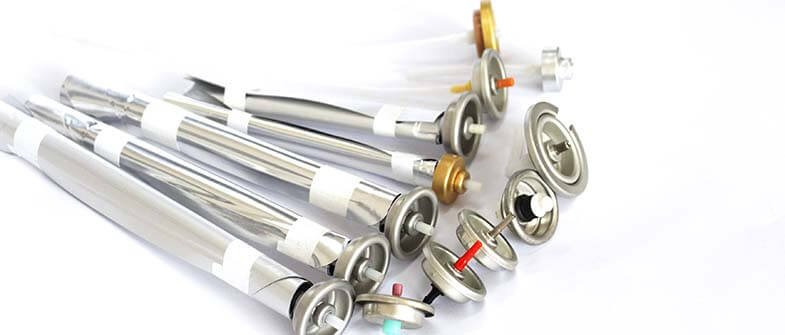8 Advantages to Use Nitrogen(N2) as Aerosol Propellant Gas
19/05/202070 years after the birth of the aerosol industry, a new propellant was discovered – nitrogen and pure compressed air containing 78% nitrogen.
These gases have been known for centuries.
But until then, they had not been seriously considered because of two major drawbacks: the majority of the gas escapes when sprayed obliquely or backwards on the aerosol; and the pressure gets lower as the product is used.
Of course, there are other issues.
However, these issues have now been resolved. And nitrogen technology is being used in a number of products – such as in bag on valve(BOV) products, piston can aerosol products and, more recently, in the original general aerosol.
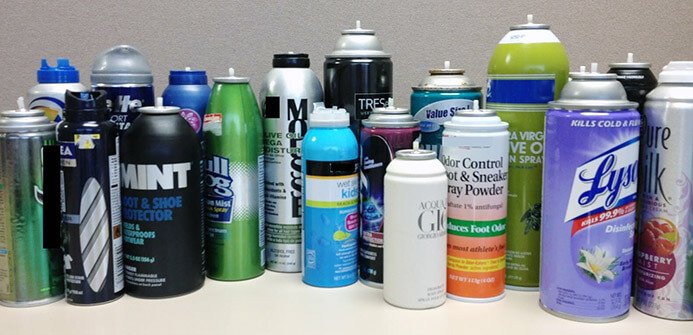
Examples of Nitrogen Aerosol Products
1. BOV Package Products
– shaving cream/foam
– body spray
– sunscreen spray
– mineral water facial spray
– olive/sunflower seed oil spray
– seawater nasal spray
– fire extinguisher
– instant self tanning spray
2. Conventional Package Products
– air fresheners and deodorants
– furniture polish (Europe)
– hard surface cleaner (Europe)
– contact lens rinse spray
– mouth freshening spray
– specific lubricants
Just to name a few. The list above is far from the whole application. We can also add cheese toppings packaged in the piston can, in-engine cleaner to the list.
Tilting the can over the horizontal level is still a problem for spraying. Therefore, developers extremely prefer to use non-bov type nitrogen aerosols that are basically used in the vertical position. For example, a bathtub cleaner may not be suitable for such an application.
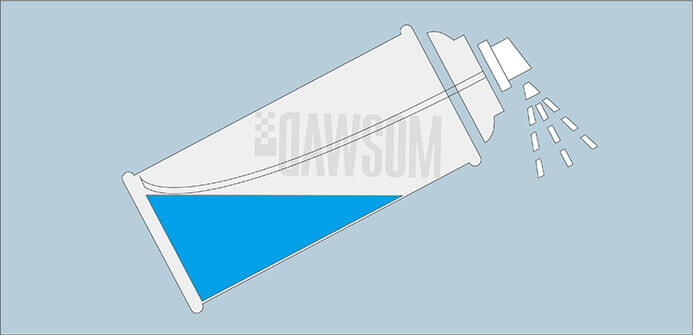
Other packaging techniques such as Jumbo (large diameter) straws or 360 degrees spray valves may be useful.
Bag on valve and piston can nitrogen aerosols are unaffected by the position of the can, and they can spray continuously when the can is at any angle.
The second major concern with all nitrogen aerosols is the steady drop in pressure as the product is used.
There are two solutions to this.
One is to use a higher initial pressure, even at 21°C (7O°F) to about 10.6kg/cm (150psig); the other is to fill the can with a little less liquid.
Common aerosols are often filled to 85% of the tank capacity, while nitrogen aerosols are usually filled to only 55% ~ 70%. For example, a popular nitrogen-filled air freshener fills about 56% of the can volume in 59mm diameter, shaped, DOT-1/2Q aluminum cans. The combination of a higher initial pressure and a reduced liquid filling volume results in best results.
There are both advantages and disadvantages for marketers when considering nitrogen aerosols.
In the United States, increasingly stringent VOC regulations have forced industry to replace liquid propellants with nitrogen or pure compressed gas.
The production of nitrogen aerosols is inexpensive.For UTC filling and TTV filling, the pressure needs to be slightly higher to compensate for the small amount of gas dissolved in the product. No more storage tanks or filling rooms are needed any more.
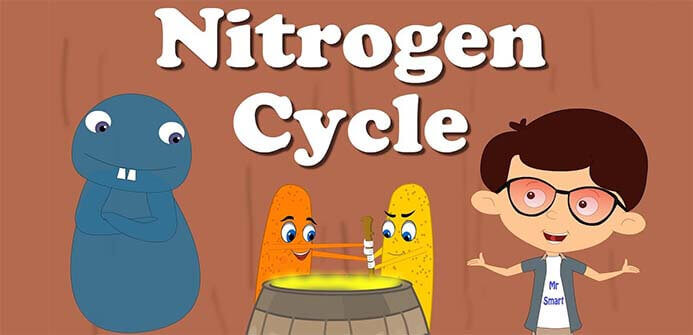
Listed below are 8 other advantages of this type of aerosol.
– Nitrogen is in complete harmony with the environment (78% of the air is Nitrogen).
– Nitrogen doesn’t burn; it’s not organic; it’s not ozone depleting.
– Nitrogen is completely inert. It is harmless and has no effect on any aerosol composition.
– O% to 0.6% nitrogen, which is commonly used in formulations, can release many products in the can.
– It can be filled with under-cap filling (U-t-C) or with a stem valve filler (T-t-V) or even with an in-line or rotary shaking filler
– The pressure rises only slightly when heated (following Charley’s Law).
– The price of propellant is almost negligible.
– The spray is almost silent (doesn’t scare pets or livestock).
There are two major drawbacks to non-bov type nitrogen aerosols.
If the aerosol canister is significantly tilted or inverted during use, a large amount of gas can be lost through the valve and the amount lost will not allow good spraying, and the residual pressure may not be sufficient for the consumer to finish the can.
To minimize this problem, the orifice can be bent in the same position as the straw. Special measures are also taken, such as fastening the nozzle very tightly around the valve cup, making it very difficult for the consumer to rotate it outside of a consistent point.
The machine is designed to automatically adjust the orientation of the actuator spray hole before it is placed in the color-marked position on the top of the valve cup, eliminating slow, difficult manual operations and advancing high-speed production.
The use of unusually high initial pressures and the reduction of the filling volume to 60% to 70% of the can capacity sometimes results in a jet-like ejection of the product, and the ejection rate is significantly reduced as the product is used.
In fact, bov nitrogen aerosols are typically pressurized to 5 kg/cm2 (71psig). For each nitrogen aerosol, the pressure and filling volume must be optimized, which is also the subjective decision of each marketer.
Other disadvantages of nitrogen aerosols are relatively minor and they are summarized as follows.
– Loss of propellant when the canister is used upside down
– MBU actuators are required.
– The spray produced is rather rough.
– The spray rate decreases slightly as the product is used.
– The gas is slightly dissolved in the product (producing unwanted foam under certain conditions)
– Some products can have reduced pressure (in steps).
– As far as quality control is concerned, the weight of the gas is negligible and the test pressure is required
– Since there is only a small amount of nitrogen in the product, even a small leak is very harmful.
Because there are so few propellants used in nitrogen aerosols, it is necessary to check pressure rather than weigh them during production.
Statistical checks can be made using an in-line pre-pressure gauge, and inaccurate checks can pass the cans through a deflector.
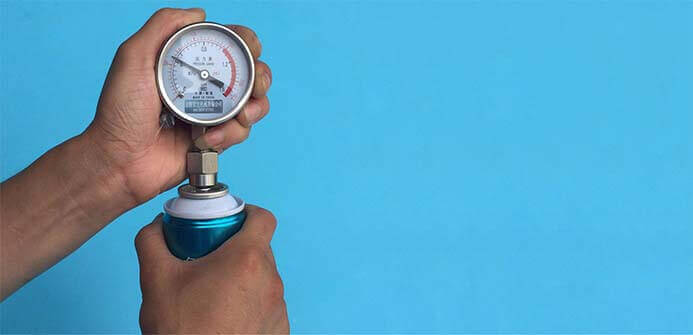
To prevent any significant long-term leakage of nitrogen or pure compressed air, the valve cup needs to be fitted with a cut-off sodium buna rubber sealing gasket, usually 1.00mm thick, which is important for single or two piece cans.
In addition, a good tight seal is required, as pressure is a key factor in developing nitrogen aerosols. So there will be more discussion here. Scientists have developed a number of pressure measurement systems, some of which are listed in Table 1.
| Unit | BOV Type | Other Types |
| kg/c㎡ | 4.89 | 8.16 |
| bar | 4.80 | 8.00 |
| psig | 69.6 | 112.3 |
| atmos | 4.74 | 7.90 |
| mercury(mm, 0℃) | 3600 | 6001 |
| kPa | 480 | 800 |
| dynes/c㎡ | 0.0000048 | 0.0000080 |
| min.(bar, around) | 4.00 | 7.00 |
| max.(bar, around) | 6.00 | 10.00 |
Because nitrogen and pure compressed air are virtually insoluble in water or organic solvents, the gas exists almost entirely in the top space of the aerosol canister and closely follows Charley’s Law.
In the water bath tank of the production line, the pressure rises only about 10% when the aerosol is heated. Table 2 shows the increase in pressure with increasing temperature.
| System | 21.1℃ | 54.4℃ |
| kg/c㎡ | 4.90 | 5.56 |
| psi-g | 69.60 | 79.10 |
| kg/c㎡ | 6.00 | 6.80 |
| psi-g | 85.20 | 96.50 |
| kg/c㎡ | 8.16 | 9.21 |
| psi-g | 112.30 | 126.70 |
| kg/c㎡ | 10.20 | 11.50 |
| psi-g | 145.00 | 163.10 |
| kg/c㎡ | 10.60 | 11.90 |
| psi-g | 150.00 | 168.60 |
For almost all nitrogen aerosols, they can be thrown into boiling water without any can deformation or bursting, which is a situation that is not possible with aerosol formulations using other propellants.
Table 3 shows the changes in pressure at different temperatures for nitrogen aerosols with higher pressure and for liquefied propellants (isobutane A-31) with lower pressure.
At 82.2°C (180℉), nitrogen aerosols can be safely contained in DOT-2O cans in the United States, while aerosols using isobutane will then deform the can and burst at 100°C (212℉).
| Temperature | Nitrogen Pressure | Isobutane Pressure |
| 21.1°C | 9.85kg/c㎡ | 2.18kg/c㎡ |
| 70.0°F | 140psig | 31.0psig |
| 40.0°C | 10.5kg/c㎡ | 4.64kg/c㎡ |
| 104.0°F | 150psig | 66psig |
| 54.4°C | 11.1kg/c㎡ | 6.82kg/c㎡ |
| 130.0°F | 158psig | 97psig |
| 71.1°C | 11.7kg/c㎡ | 9.78kg/c㎡ |
| 160.0°F | 166psig | 139psig |
| 82.2°C | 12.1kg/c㎡ | 13.9kg/c㎡ |
| 180.0°F | 172psig | 198psig |
| 100.0°C | 12.8kg/c㎡ | 720kg/c㎡ |
| 212.0°F | 181psig | >284psig |
In addition, if a nitrogen aerosol is heated so strongly that the canister ruptures, it poses far less of a hazard than an explosion of an aerosol containing a liquid propellant.
Nitrogen aerosol may drop in pressure by 65% ~ 100% over the entire life of the aerosol depending on the amount of filling.
For example, if a nitrogen aerosol fill is 85% of the can volume, pressurized with nitrogen to 7.O3kg/cm2 (1OOpsig), in the spray 95% of the contents, the residual pressure is 0.2kg/cm2 (3psig).
When 20% ~ 25% of the product remains in the can, the spray will change and the product will become completely unacceptable. This also demonstrates the importance of keeping the nitrogen aerosol charge to approximately 55% ~ 70% of can capacity.
The pressure changes in nitrogen aerosol closely follow Boyle’s law.
For example, if the gas volume of the aerosol is 40% and the pressure is 10kg/cm2 (absolute), a slight dissolution of nitrogen and pure compressed air in the product may result in a final reading of 4.05 ~ 4.1Okg/cm2, and the pressure drop during use can be easily calculated.
The usual process is to deduct the gas dissolved in the product and consider what the pressure is when 95% of the product is discharged, using different percentages of the product load can be prepared for any given initial gas pressure table or graph.
The following data are given for nitrogen aerosol at an initial pressure of 10.55 kg/cm2 at 21.1°C (70℉) and a filling volume ranging from 65% to 72.5% of the can volume.
Considering that the pressure is the absolute upper limit of high strength (DOT-2Q) aerosol cans, the use of such high pressures requires special testing of the cans and valves, including continuous storage at 54.4 °C (130℉).
Although US DOT-2Q aerosol cans can withstand pressure up to about 13.4kg/cm2 (19Opsig) without permanent deformation, it is necessary to take into account long-term creep, leakage and valve cup deformation, etc., measured with a pre-pressurized pressure gauge.
Consumer product pressure drops during nitrogen aerosol use
For example, at 21.1°C, the initial pressure is 10.55 kg/cm (10.34 bar). Measure the pressure when 95% of the product is ejected.
When the filling volume is 72.5% of the can capacity, the final pressure is 2.27kg/cm2
When the filling capacity is 70% of the can capacity, the final pressure is 2.57kg/cm2
When the filling volume is 67.5% of the can capacity, the final pressure is 2.86kg/cm2
When the filling volume is 65% of the can capacity, the final pressure is 3.16kg/cm2
The following is based on a more reasonable initial pressure of 7.03kg/cm (1OOpsig) at 21.1°C, with a lower pressure occurring as expected after 95% of the product is ejected.
The initial pressure is 7.03 kg/cm (6.70 bar) at 21.1°C. Measured the pressure when 95% of the product is ejected.
– Filling volume is 72.5% of the can capacity, final pressure is 1.27kg/cm2
– Filling capacity is 65% of the can capacity, final pressure 1.85kg/cm2
– Filling capacity is 60% of the can capacity, final pressure 2.29kg/cm2
-Filling capacity 55% of can capacity, final pressure 2.70kg/cm2
The product should preferably be loaded at 55% ~ 60% of the can volume, as this will result in a reasonable final pressure after 95% of content is ejected, producing a satisfactory mist pattern without “hot spots” or central jets.
The bov type nitrogen aerosol products are usually released like lotion or foam, as the product is filled into the bag so that the initial pressure generated by the bov expansion at 21.1 ℃ is usually 5.27kg/cm2 (75psig).
Excessive pressure can cause these products to spew out. It is therefore necessary for the formulator to optimize the filling volume and final pressure.
Because even a fairly low pressure is sufficient to allow the lotion and foam to be quickly squeezed out through the commonly used large diameter valves. So they use lower pressure.
Some values are given above for a filling volume of 60% ~ 70%.
Nitrogen aerosol technology is opening a new page in the continued development of new as well as useful aerosol products.
Although nitrogen aerosols account for only a small fraction of the total aerosol production, we can expect to see an increase in such products, driven by environmental concerns, security considerations and economic considerations.
As with the vast majority of new developments, they always have advantages and disadvantages. A resourceful aerosol industry will be able to solve most of the problems along the way and pave the way for future market success.
Recent Posts
-
2 Ways You Can Take to Avoid Aerosol Can Corrosion Leaks
 After many years of scientific research, it has been found that HFCs, which used to be used as aerosol propellants, have a certain destructive effect on the ozone layer, so the production of CFCs in Europe and the United States is restricted by law.
After many years of scientific research, it has been found that HFCs, which used to be used as aerosol propellants, have a certain destructive effect on the ozone layer, so the production of CFCs in Europe and the United States is restricted by law. -
23 Aerosol Propellant Losses Will Cost You Money and Ruin Your Plant
 Did you know that aerosol propellants can be lost in 23 places? It is not only the propellant gas and money that are lost, but also the possibility of destroying the plant. Since there is almost no way to monitor and measure the use of propellants, it is very easy to lose them
Did you know that aerosol propellants can be lost in 23 places? It is not only the propellant gas and money that are lost, but also the possibility of destroying the plant. Since there is almost no way to monitor and measure the use of propellants, it is very easy to lose them -
9 Key Factors to Consider will Make You Select the Right Aerosol Valves
 Aerosols have played an important role in people's daily lives since their invention, production and application in the 1920s. It has a wide range of applications, such as personal care, household care, pest control, medical solutions, industrial care and food, etc., bringing great convenience to human life.
Aerosols have played an important role in people's daily lives since their invention, production and application in the 1920s. It has a wide range of applications, such as personal care, household care, pest control, medical solutions, industrial care and food, etc., bringing great convenience to human life.
Maximize Your ROI
by Investing in Our Cost-Effective Aerosol Filling Machines.
Contact Us
Copyright© 2019 Dawsom Mechanical & Electrical Co., Ltd. All Rights Reserved.



